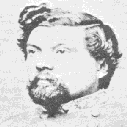
Thomas Lafayette Rosser, Confederate Army officer, was born on October 15, 1836, in Campbell County, Virginia, the son of John and Martha Melvina (Johnson) Rosser. In 1849 the family moved to a 640-acre farm in Panola County, Texas, some forty miles west of Shreveport, Louisiana. As his father was compelled by business to remain for a while in Virginia, Tom Rosser, at age thirteen, led the wagon train bearing his mother and younger siblings to Texas. For four years he attended the Mount Enterprise school in Rusk County. Upon the nomination of Congressman Lemuel D. Evans, Rosser entered the United States Military Academy at West Point on July 1, 1856; he resigned on April 22, 1861, only two weeks before graduation, when Texas left the Union.Among his fellows in the class of 1861 was George A. Custer, who graduated dead last in a field of thirty-four cadets.
Rosser was commissioned a first lieutenant in the regular Confederate States Army and assigned as an instructor of artillery. He commanded a company of the New Orleans Washington Artillery battalion at the first battle of Manassas (Bull Run) and was wounded at the battle of Mechanicsville. He returned to the army after recovering and was appointed colonel and commander of the Fifth Virginia Cavalry at the instigation of Gen. James E. B. (Jeb) Stuart. Rosser was promoted to brigadier general on September 28, 1863, and given command of one of Stuart's divisions. He was given command of the Confederate cavalry in the Shenandoah Valley in October 1864 and promoted to major general on November 1. In 1865 he rejoined Gen. Robert E. Lee's Army of Northern Virginia at Petersburg and took part in the Appomattox campaign. Refusing to surrender, he cut his way out of the federal lines and attempted to lead his division to a junction with the army of Gen. Joseph E. Johnston in North Carolina. He was intercepted and captured, however, and paroled in May. After the war he returned to Virginia, where he became chief engineer of the Northern Pacific and Canadian Pacific railroads. He later became a planter in Charlottesville. On June 10, 1898, President William McKinley appointed Rosser a brigadier general of United States volunteers for the Spanish-American War. He was honorably discharged on October 31, 1898. He died at Charlottesville on March 29, 1910, and is buried at Ridgeview Cemetery.
| History of the War in the Valley | Historic Places | Tour | Valley Museums | Soldiers and Civilians | Site Map | Valley Historical Links |
|
|
||||||